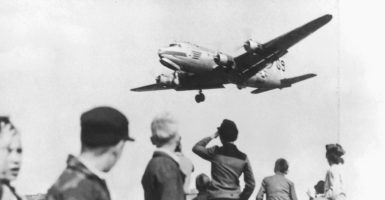Two weeks ago, on June 6, we commemorated D-Day—the start of the land battle to free Europe from Nazi tyranny.
On Thursday, we celebrate another significant anniversary. It was 70 years ago, on June 20, 1948, that the U.S. and its allies started their first major fight of the Cold War, aiming to stop mass murderer and tyrant Josef Stalin from enslaving more people in Europe: the Berlin Airlift.
When World War II ended, Germany was divided into four zones, with one each controlled by the Americans, the British, the French, and the Russians. Berlin, which was entirely in the Russian sector, was also divided into four zones, to the great annoyance of the Russians.
The Russians had brutally subjugated their portion of Germany, including Berlin, raping and pillaging like the Mongols during the Middle Ages. Everyone who could—including my grandmother—tried to get out of the Russian zone. She bribed a guide to smuggle her and her 10-year-old daughter past Russian patrols into the American sector, where she was reunited with my mother and her other two daughters in a refugee camp.
The portion of Berlin not occupied by the Russians was an island of liberty in a sea of totalitarian tyranny. Stalin was intent on capturing the rest of Europe. In February 1948, the Russians staged a coup in Soviet-occupied Czechoslovakia, throwing out its democratic government and installing a communist puppet government.
Next on Stalin’s list was Berlin. Stalin was angered by American, British, and French plans to create a new German state out of their occupation zones.
In what became the first major confrontation of the Cold War, the Russian army cut off electricity to the city as well as all railroad, road, and barge traffic from the West into Berlin. This made it impossible for the Americans, British, and French to bring in the food, fuel, and other supplies needed for 2 million German civilians and Allied troops.
Stalin assumed the Allies would capitulate quickly and hand over Berlin. Future Soviet leader Nikita Khrushchev later said Stalin’s move against Berlin was “prodding the capitalist world with the tip of a bayonet.”
But, as had so many others before him, Stalin underestimated President Harry Truman, who realized the importance of what was happening. Gen. Lucius Clay, commander of the U.S. zone, proposed sending army convoys to run though the blockade. Truman rejected that as too risky, since it might get us into a shooting war with the Russians.
Instead, he ordered a massive effort to supply Berlin by air, something that no one thought could be done. He also sent three squadrons of B-29s to bases in Great Britain and Germany, fooling Stalin into thinking they were equipped with atomic bombs (they weren’t).
The only way to bring in the supplies needed to keep the city from starving and freezing to death was to run the airlift round the clock, with planes landing at Tempelhof Airport in Berlin in a continuous air chain between Berlin and the West. At its peak, the airlift had a plane landing at Tempelhof every 45 seconds. The Americans were joined by the French, British, Australians, New Zealanders, South Africans, and Canadians.
Fleets of C-47s and C-52s, accompanied by fighter escorts, were bringing in 4,500 tons of supplies a day by December 1948, and they upped that to 81,000 tons a day by spring of 1949. It was an exhausting, back-breaking effort by the air and ground crews that loaded, unloaded, maintained, and flew the aircraft day after day, month after month.

The Royal Air Force and U.S. Air Force flew over 200,000 flights during the Berlin Airlift. (Photo: akg-images/Newscom)
The massive effort took the Soviets by surprise. They were sure the Allies would quickly withdraw from Berlin. They were astonished by the mammoth logistics of the American supply chain. One Russian officer said the aircraft flying into Berlin one after another looked like a conveyor belt.
On May 12, 1949, Stalin realized he had been beaten and lifted the blockade. It was the biggest, longest airlift supply mission in history and has not been equaled since.
The move on Berlin also proved a grave political mistake by Stalin. Americans were tired of war when World War II ended, and there was a great push in the United States to disarm and return to an inadequate, peacetime military.
Stalin’s effort to seize Berlin made many Americans and politicians in Washington realize we were facing an expansionist, murderous dictator and a communist ideology as bad as Nazism.
As historians Larry Schweikart and Michael Allen point out in “A Patriot’s History of the United States,” if Stalin had not woken up Americans with his threat against Berlin, the U.S. might have “disarmed so thoroughly that re-arming would have been politically impossible” and Stalin’s “divisions might have simply walked into Berlin.”
The Berlin Airlift and the defeat of the Soviet blockade was a tremendous victory against the Soviet communist empire. And it was a bloodless victory won by the technology, hard work, and sheer grit of freedom-loving people determined not to allow tyranny to be imposed on another outpost of freedom.
The Iron Curtain that enslaved tens of millions for decades was already descending on Europe, but Berlin was one place where we kept the bright lights of freedom burning.
And that included part of my family. One of my mother’s cousins, a medical doctor, was in Berlin with his family and was saved by the Berlin Airlift. If it hadn’t been for Truman and the American and Allied military personnel who battled the Soviets in the air for almost a year, he and his wife and daughters would have ended up in a despotic police state like so many other Germans did.
But thanks to the determination of the West 70 years ago, my relatives and millions of others lived in freedom.





























